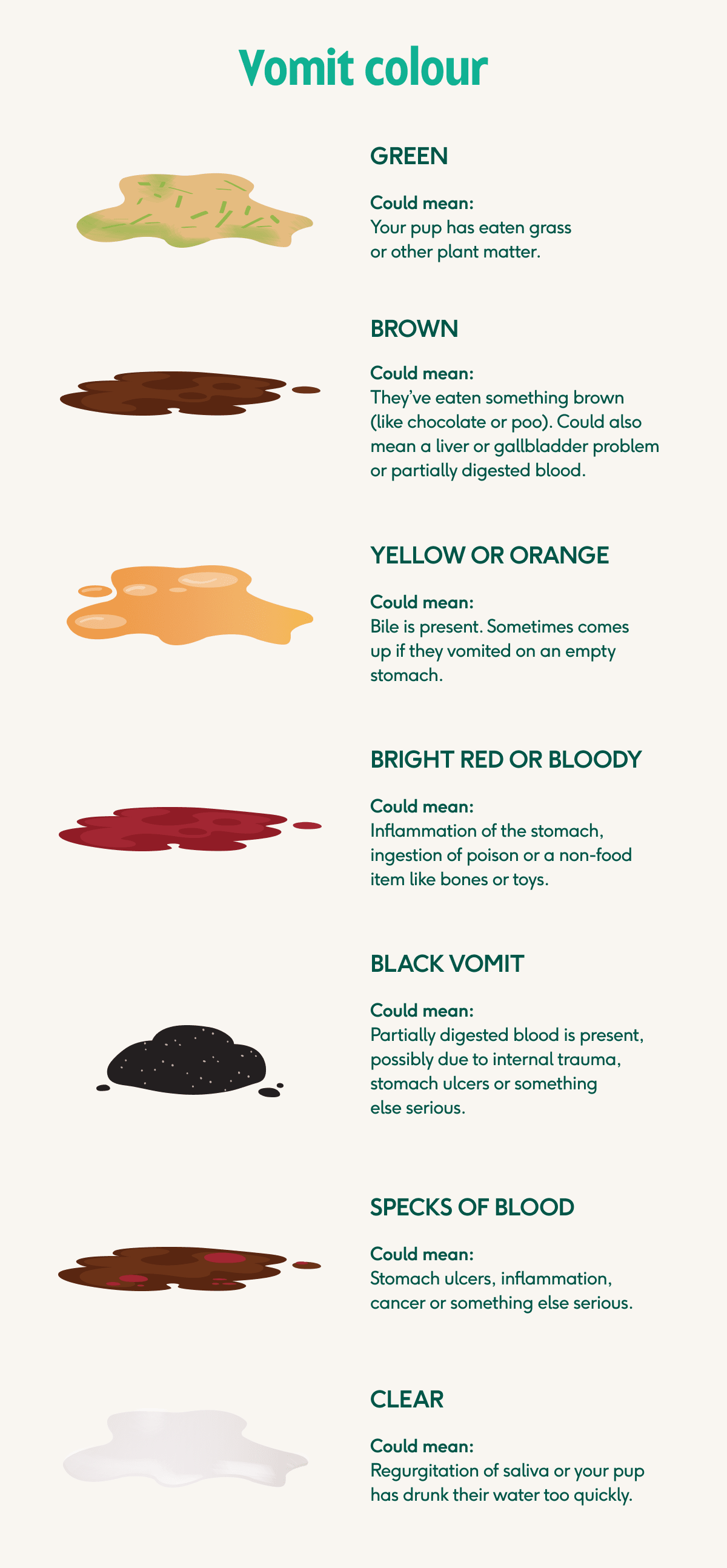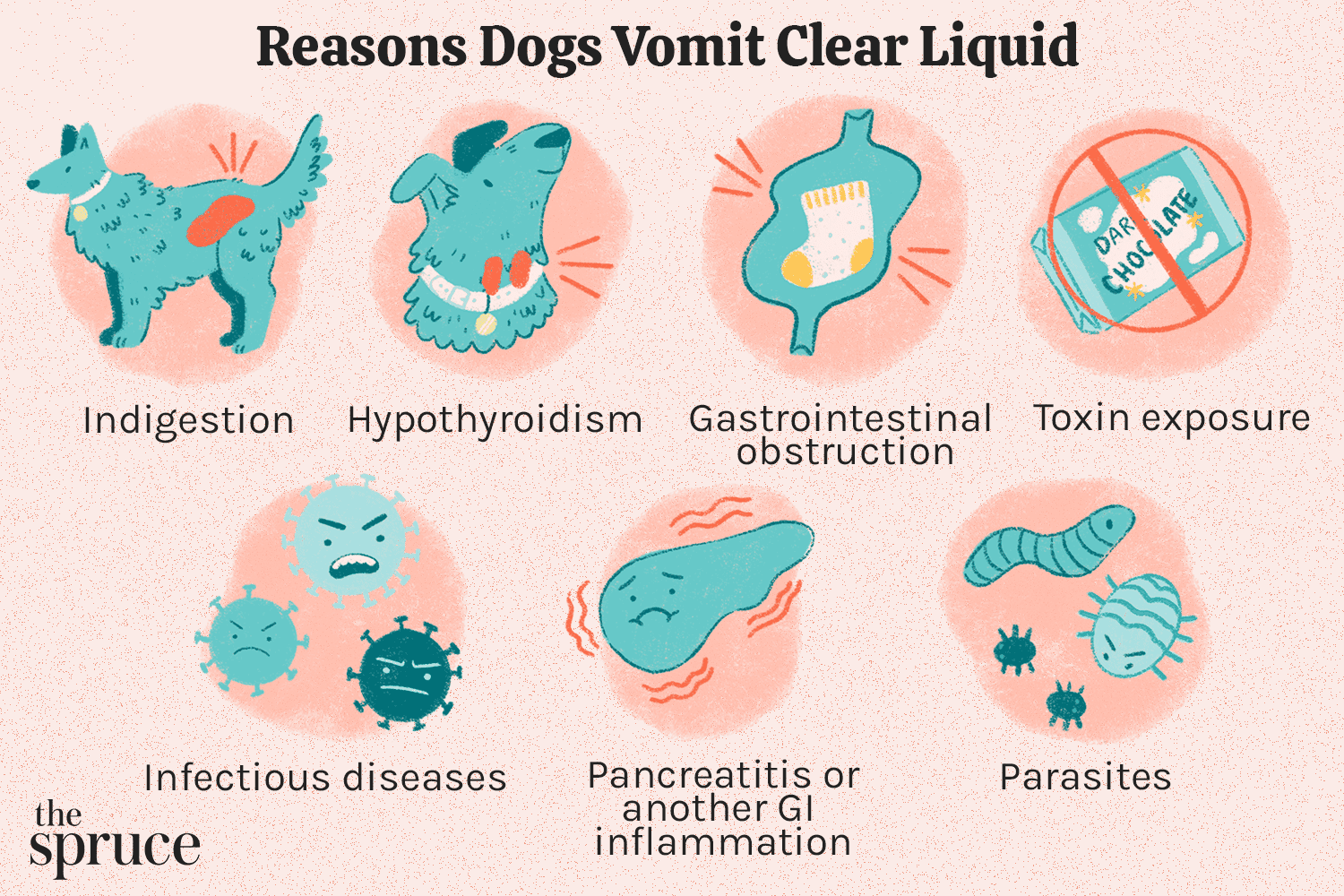Seeing your dog throw up can be alarming. It’s even more concerning when they vomit clear liquid.
This can indicate various issues, from mild to serious. Understanding why your dog is throwing up clear liquid is crucial. Dogs may vomit for many reasons, including dietary changes, stress, or health problems. Clear liquid vomit often means the stomach is empty.
This situation might be due to nausea or other digestive issues. Observing your dog’s behavior is essential. Are they acting normal? Do they have other symptoms? Knowing what to look for can help you decide if a vet visit is needed. In this guide, we will explore the causes, remedies, and steps to take when your dog experiences this distressing issue.

Credit: www.petmd.com
Recognizing The Signs
When your furry friend starts acting a bit off, it can be a cause for concern. One of the more alarming signs is if your dog begins throwing up clear liquid. Understanding what this might mean is essential for ensuring your pup’s well-being. In this section, we will focus on two critical aspects: identifying clear vomit and differentiating it from regurgitation. Let’s dive in!
Identifying Clear Vomit
First things first, what exactly does clear vomit look like? Clear vomit usually appears as a watery substance, sometimes resembling saliva. It’s often a sign that your dog’s stomach is empty. Here are some key points to help you identify it:
- Color: As the name suggests, it’s clear or slightly cloudy.
- Texture: It may be thin and watery.
- Smell: It might not have a strong odor, but you may notice a hint of bile.
If you observe these characteristics, it’s likely your dog is dealing with clear vomit. Remember, it’s not just about what comes up; it’s also about how your dog behaves. Is Fido acting lethargic? Is he refusing to eat? These signs can help you determine whether to call the vet.
Differentiating Vomit From Regurgitation
Now, let’s talk about the difference between vomiting and regurgitation. It’s easy to mix them up, but knowing the difference can help you understand your dog’s condition better.
| Feature | Vomiting | Regurgitation |
|---|---|---|
| Process | Involves active effort; your dog might heave. | Passive; food comes back up without effort. |
| Content | May include food, bile, or clear liquid. | Usually undigested food or liquid. |
| Timing | Can happen after eating or drinking. | Often occurs shortly after eating. |
Understanding these differences can be crucial. If your dog is vomiting clear liquid but is still playing like a puppy, it might not be as serious as regurgitating undigested food. However, if your dog seems uncomfortable or shows other signs of illness, don’t hesitate to reach out to your veterinarian.
In conclusion, recognizing the signs of your dog throwing up clear liquid is vital. By identifying the characteristics of clear vomit and differentiating it from regurgitation, you’ll be better equipped to make informed decisions about your pet’s health. Always remember, when in doubt, a quick call to your vet can provide peace of mind!

Credit: excelso.ca
Common Causes Of Clear Vomiting
When your furry friend starts throwing up clear liquid, it can be a worrying sight. As pet owners, we want to ensure our dogs are healthy and happy. Clear vomiting can sometimes indicate a range of issues that might be affecting your dog’s stomach. Understanding the common causes behind this behavior can help you decide the best course of action. Let’s dive into some of the most frequent reasons your dog might be experiencing clear vomiting.
Digestive Issues
One of the most common causes of clear vomiting in dogs is digestive issues. Just like us, dogs can have upset stomachs. Here are a few potential digestive problems:
- Gastritis: This inflammation of the stomach lining can lead to vomiting clear liquid.
- Empty Stomach: Sometimes, if your dog hasn’t eaten for a while, they may vomit bile or clear liquid.
- Food Intolerance: Certain foods might not sit well with your dog’s stomach, causing them to vomit.
Have you ever skipped breakfast and felt queasy? Imagine how your dog feels when they’re hungry! If your dog is throwing up because of an empty stomach, a regular feeding schedule can help.
Dietary Indiscretions
Dogs are curious creatures, and their love for exploring can lead them into trouble. Dietary indiscretions are a fancy way of saying they might have eaten something they shouldn’t have. Here are some examples:
- Eating garbage or spoiled food.
- Snacking on plants or flowers that are toxic.
- Ingesting human food that their stomach can’t handle.
Just like that time you snuck a cookie before dinner, not everything that looks good is good for them! Keeping an eye on what your dog munches on is crucial. If you suspect they’ve eaten something harmful, it’s best to consult your vet.
Infections And Illnesses
Sometimes, clear vomiting can be a sign of more serious health issues. Infections and illnesses can lead to this troubling symptom. Here’s what you should watch for:
- Parvovirus: A serious viral infection that can cause vomiting and diarrhea.
- Gastroenteritis: Inflammation of the stomach and intestines can result in clear vomiting.
- Pancreatitis: This condition occurs when the pancreas becomes inflamed, often leading to vomiting.
If your dog shows other signs of illness, like lethargy or diarrhea, it’s time to call the vet. Remember, better safe than sorry! It’s always better to be on the cautious side when it comes to our beloved pets.
In summary, clear vomiting can stem from various causes. By understanding these common issues, you can take better care of your furry friend. Keep a close eye on their behavior and don’t hesitate to seek professional help if you’re concerned!
Initial Response To Vomiting
Seeing your dog vomit can be distressing. Clear liquid vomit often signals an upset stomach. Quick action is important to ensure your dog’s health. Follow these steps to respond effectively.
Assessing Your Dog’s Condition
First, check your dog’s behavior. Look for signs of discomfort or pain. Is your dog acting normally? Is it lethargic or restless? Observe how often your dog vomits. Take note of any additional symptoms. These may include diarrhea, lack of appetite, or fever.
Gently feel your dog’s abdomen. Is it hard or swollen? This could indicate a more serious issue. Look for any unusual changes in your dog’s gums. Pale or yellow gums can be a concern. If you notice any of these signs, contact your veterinarian.
Removing Food And Water Temporarily
Stop feeding your dog for a few hours. This gives the stomach time to settle. After that, offer small amounts of water. This helps prevent dehydration. If your dog keeps the water down, wait a bit longer.
After a few hours, you can reintroduce food. Offer a bland diet like boiled rice and chicken. Start with small portions. Observe if your dog keeps the food down. If vomiting continues, seek veterinary help.
Home Remedies For Immediate Care
When your dog throws up clear liquid, it can be concerning. Taking quick action is vital. Home remedies can help ease your dog’s discomfort. Here are some effective methods to try.
Hydration And Electrolytes
Keeping your dog hydrated is crucial. Vomiting can lead to dehydration. Offer small amounts of fresh water. You can also give an electrolyte solution. Look for dog-safe options at pet stores.
Encourage your dog to drink often. Use a syringe without a needle if needed. This helps provide hydration without overwhelming their stomach.
Gentle Diet Introduction
After a few hours of rest, introduce a gentle diet. Start with plain, boiled rice or boiled chicken. These are easy on the stomach. Serve small portions to avoid further upset.
Gradually increase the amount over time. Watch for any signs of discomfort. If your dog continues to vomit, stop the diet and consult a vet.
Probiotics And Digestive Enzymes
Probiotics can help restore gut health. They support digestion and reduce vomiting. Look for dog-specific probiotic supplements.
Digestive enzymes can also aid in breaking down food. This makes it easier for your dog to digest meals. Consult your vet for proper dosage and recommendations.
When To Consult A Veterinarian
Seeing your dog throw up clear liquid can be alarming. As a pet owner, it’s only natural to feel a bit worried. You might wonder, “Is this serious?” or “Should I wait it out?” While occasional vomiting can be normal, there are times when your furry friend needs a helping hand from a vet. Let’s break down when it’s time to reach out for professional help.
Warning Signs For Emergency
It’s essential to know the signs that indicate your dog might need immediate medical attention. If you notice any of the following, don’t hesitate—call your veterinarian right away!
- Repeated Vomiting: If your dog is throwing up clear liquid multiple times in a short period, that’s a red flag.
- Blood in Vomit: Blood can be bright red or look like coffee grounds, and either is concerning.
- Abdominal Pain: If your dog seems to be in pain or is whining when you touch their belly, it’s time to seek help.
- Weakness or Lethargy: If your pup is unusually tired or weak, it could signal a bigger issue.
- Loss of Appetite: If your dog refuses to eat for more than 24 hours, this can be a sign of trouble.
- Diarrhea: If vomiting is accompanied by diarrhea, especially if it’s severe, don’t wait to consult a vet.
Preparing For The Vet Visit
Once you’ve decided to take your dog to the vet, preparation can make the visit smoother. Here’s a quick checklist to help you get ready:
- Gather Information: Write down when the vomiting started and any other symptoms you’ve noticed. This information will be very helpful for the vet.
- Collect Samples: If possible, bring a sample of the vomit. This can help the vet make a quicker diagnosis.
- Note Any Changes: Have you changed your dog’s diet recently? Did they eat something unusual? Note these changes, as they can be crucial clues.
- Bring Medical Records: If your dog has a history of health issues, bring their medical records. It’s like a mini biography for your pet!
- Stay Calm: Dogs can sense our emotions. If you’re calm, your dog will likely feel more at ease too.
In conclusion, knowing when to consult a veterinarian can make all the difference. Keeping an eye on warning signs and being prepared for your vet visit not only helps your dog but also gives you peace of mind. Remember, your furry friend depends on you to be their voice. So, when in doubt, don’t hesitate to reach out!
Veterinary Interventions
Seeking veterinary help is crucial for your dog. Clear liquid vomit can indicate several issues. A vet can find the cause. Early intervention can lead to better outcomes.
Diagnostic Tests
Your vet may recommend several tests. Blood tests can check for infections or organ problems. X-rays or ultrasounds may reveal blockages. Fecal tests can identify parasites. These tests help form a complete picture of your dog’s health.
Treatments For Underlying Conditions
Once the vet identifies the issue, treatment begins. Medications can help with infections or inflammation. Dietary changes may be necessary for digestive issues. Sometimes, surgery is needed for serious conditions. Follow your vet’s advice closely for the best care.
Preventing Future Episodes
Finding your furry friend throwing up clear liquid can be alarming. Thankfully, there are steps you can take to help prevent future episodes. It’s not just about treating the symptoms; it’s about understanding what might have caused them in the first place. Let’s dive into some effective strategies that can keep your pup feeling great!
Dietary Management
The first step in keeping your dog healthy is to pay attention to what goes into their bowl. A proper diet can greatly reduce the chances of vomiting clear liquid. Here are some tips:
- Balanced Diet: Ensure your dog’s food is rich in nutrients. Look for high-quality, vet-recommended brands.
- Frequent, Smaller Meals: Instead of one big meal, try feeding your dog smaller portions throughout the day. This can help reduce the risk of an upset stomach.
- Avoid Table Scraps: While it’s tempting to share your dinner, human food can sometimes be too rich for dogs.
- Monitor Treats: Be mindful of the treats you give. Too many can upset their tummy.
Regular Health Check-ups
Just like us, dogs need regular health check-ups. Think of it as a routine pit stop for your pup! These visits can help catch any potential issues early on:
- Annual Vet Visits: Make it a habit to take your dog to the vet at least once a year for a thorough check-up.
- Vaccinations: Ensure your dog is up-to-date on their vaccinations. This can prevent many illnesses that could lead to vomiting.
- Dental Care: Don’t forget about dental health! Poor oral hygiene can lead to digestive issues.
Stress Reduction Strategies
Stress can be a sneaky culprit when it comes to your dog’s health. Dogs experience anxiety just like we do, and it can lead to gastrointestinal issues. Here are some strategies to help keep your pup chill:
- Consistent Routine: Dogs thrive on routine. Try to feed, walk, and play with them at the same times each day.
- Safe Space: Create a quiet area in your home where your dog can retreat when they feel anxious.
- Positive Reinforcement: Use treats and praise to encourage calm behavior. This can help build their confidence.
- Exercise: Regular exercise is a fantastic way to reduce anxiety. A tired dog is often a happy dog!
In conclusion, by managing your dog’s diet, scheduling regular vet visits, and reducing stress, you can significantly lower the chances of future vomiting episodes. Remember, a happy dog means a happy owner! So, let’s keep those tails wagging and those bellies happy.

Credit: lyka.com.au
Monitoring Your Dog’s Recovery
When your furry friend starts throwing up clear liquid, it can be a worrying experience. As a responsible pet owner, it’s essential to monitor your dog’s recovery closely. Keeping an eye on their condition can help you catch any potential issues early and ensure they get back to their playful selves as soon as possible. So, what should you do? Let’s dive into a couple of important aspects of monitoring your dog’s recovery.
Tracking Symptoms
First things first, keeping track of your dog’s symptoms is crucial. Make a note of:
- How often they are vomiting
- The amount of clear liquid they are bringing up
- Any changes in appetite or energy levels
- Signs of dehydration, such as dry gums or excessive thirst
It can be helpful to keep a simple log. For example:
| Date | Time | Symptoms |
|---|---|---|
| Monday | 8:00 AM | Vomited clear liquid twice |
| Monday | 1:00 PM | Refused food |
| Monday | 6:00 PM | Drank water normally |
By tracking these details, you can provide your vet with valuable information if the situation doesn’t improve. Plus, it gives you peace of mind—like having a little diary for your pup’s health!
Adjusting Care As Needed
As your dog recovers, you may need to adjust their care. Here are some tips:
- Diet Changes: Start with bland foods like boiled chicken or rice. Gradually reintroduce their regular food as they improve.
- Hydration: Ensure they have access to fresh water. If they can’t keep it down, consult your vet.
- Rest: Allow your dog to rest. Just like us, dogs need time to recover. Avoid strenuous activities until they feel better.
- Vet Visits: If vomiting persists or other symptoms arise, don’t hesitate to visit the vet. Trust me, they’ll appreciate your attention more than that squeaky toy!
Remember, every dog is unique. What works for one might not work for another. Keep an eye on their behavior, and adjust your approach as needed. After all, you know your pup better than anyone!
Frequently Asked Questions
How Do You Treat A Dog That Vomits Clear Liquid At Home?
To treat a dog vomiting clear liquid at home, ensure they stay hydrated. Offer small amounts of water or ice chips. Monitor their behavior and food intake. Withhold food for 12-24 hours, then reintroduce a bland diet. Consult a vet if vomiting persists or worsens.
Should I Be Worried If My Dog Throws Up Water?
Occasional water vomiting in dogs can be normal, especially after drinking too quickly. Observe for signs of distress, like lethargy or continued vomiting. If symptoms persist or worsen, consult a veterinarian promptly. Early detection can help prevent serious health issues.
What Does Throwing Up Clear Liquid Mean?
Throwing up clear liquid often indicates an empty stomach. It may also signal dehydration or a gastrointestinal issue. Common causes include nausea, anxiety, or viral infections. Persistent vomiting should prompt a visit to a healthcare professional for proper evaluation and treatment.
How To Settle A Dog’s Stomach After Vomiting?
To settle a dog’s stomach after vomiting, offer small amounts of water. Gradually introduce bland foods like boiled chicken and rice. Monitor your dog for any persistent symptoms. Consult a veterinarian if vomiting continues or if your dog shows signs of distress.
Keep your dog calm and rested.
Conclusion
Seeing your dog throw up clear liquid can be alarming. This may signal an empty stomach or a health issue. Quick action is important. Keep a close eye on their behavior. Offer small amounts of water to keep them hydrated.
Contact your vet if symptoms persist or worsen. Timely help can make a big difference. Remember, your dog relies on you for care. Staying informed helps you make the best choices for their health. Always trust your instincts as a pet owner.




